Forbidden City, part 2
May 24th, 2010 1 Comments Category: China Destinations Feed for this Entry
The first part described main attractions in Forbidden City. The part 2 will describe the exhibition halls,the nine dragon screen, doorways, pots, sculptures, decorative tiles, roofs, beams, ceilings ,windows, gargoyles, ballustrades, walls and other places of interest.
The Exhibition Halls(Chinese: 展览馆)
Some of the buildings in the forbidden city with more minor original functions have been internally converted to hold permanent, but sometimes changing, exhibitions of artefacts of various types - including clocks, ceramics, paintings and bronzes. But first, a little background.
The Imperial Studios(Chinese: 工艺美术馆)
The emperors of China retained artists and craftsmen to manufacture works of the highest quality both to please their senses and add weight to their claim of legitimacy. Under the Qing dynasty, imperial porcelain makers from JingDeZhen introduced new glazes, shapes and techniques. The imperial studios produced paintings with traditional themes such as portraiture, landscapes, birds and flowers, and religious subjects, as well as detailed representations of political ceremonies, military conquests, and imperial processions.
Unlike earlier dynasties, the Qing court also employed Jesuit artists from Europe, whose introduction of western painting techniques and aesthetics stamped the academy as a whole with a unique visual flavor.
Religious Art(Chinese: 宗教艺术)
The Qing emperors retained their sacred Manchurian traditions, performing shamanistic rituals within the seclusion of the Forbidden City. In addition, they became ardent supporters of tantric Buddhism, imported from Tibet and Mongolia. Tibetan monks, stationed at the Hall of Uprightness, were employed as artists to produce religious objects for the emperor.
One example of their fine handiwork is the gilded alms bowl laced with eight dragons and Buddhist symbols. In contrast to its inherent symbolism, the bowl is opulently lined with silk and threaded with gold brocade.
Another example is the gold figure of Maitreya-the Buddha of the future who waits patiently in heaven, bestowing his limitless compassion on human beings until he is reborn on earth in 548 million years. Composed of solid gold and encrusted with pearls, the figure stands nearly twenty inches in height and weighs more than forty-two pounds.
Textiles and Apparel(Chinese: 纺织品和服饰)
Throughout their long reign, the Manchu leaders of the Qing dynasty strove to retain their own culture while adopting that of their subjects as well. This balance between cultural assimilation and isolationism is evident in the decrees issued for imperial apparel within the Forbidden City.
Reflecting the nomadic heritage of the rulers, robes were close-fitting on top and slit on the sides to allow comfort in the saddle. Sleeves were tight around the arms to keep out the wind, and the 'horse-hoof' shaped cuffs flared out to protect the hands. However, although the cut and style of the robes depicted Manchu style, the color and symbolism of court apparel followed the traditional Chinese pattern. Bright yellow was reserved for the emperor, empress and empress dowager. Likewise, the dragon, long a symbol of the emperor in China, was a principal motif not only for stately court robes but also for the emperor's accoutrements.
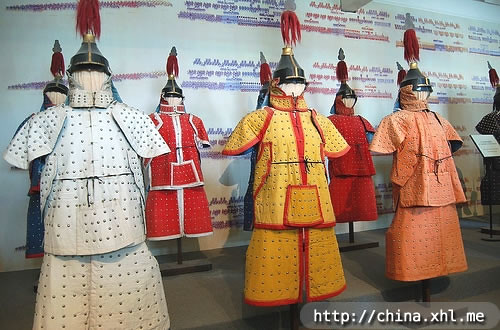
As Manchu women rejected the traditional Chinese practice of footbinding, their feet appeared large in the eyes of their Chinese subjects. To make their feet look less inelegant, they adopted a style of shoe with a high platform, which forced them to take the small steps characteristic of Chinese women whose feet had been bound.
The Hall of Clocks and Watches(Chinese: 钟表馆)

Entance to the Hall of Clocks and Watches.
From the courtyard between the Inner and Outer Courts, turn to the east and you will see a gallery behind the Palace of Earthly Tranquility to the north-east. It is located in the east of the Inner Court through the Gate of Respect Movement (Jing Yun Men).
The Hall for Ancestral Worship (FengXianDian) was built in 1656 during the Qing dynasty. It has a front hall and a rear hall, which are connected by a lobby. Its main function was to offer sacrifices to imperial ancestors. Grand sacrifice ceremonies would be held in its front hall on important occasions. On the days of their ancestors' birth, death and traditional festivals, ceremonies would be held in the rear hall. Shrines and statues in the hall were destroyed during the Cultural Revolution.
The lobby has been expanded and now the hall looks almost square inside. This hall is now open to the public as the Clock and Watch Exhibition Hall.

This exhibition hall houses about 200 clocks and watches from the imperial collection. These watches and clocks are mostly made in Switzerland, England, France, the U.S and Japan, gifts presented to the emperor by envoys. Some Chinese made timepieces are also on display.

There are two clocks that deserve the greatest attention. You can easily see them when you enter the Hall. The one on the left is a Chime Clock, it was made during the Qing Dynasty, around 1797, by the royal clockmakers. This clock can still run up to 72 hours after it is well wound and it can also strike hours and quarters. It is 5.85 metres high and stands on a 2.6 metre high square base.
Symmetrically standing on the right hand side is a huge water clock made in 1799. The clock is 6 metres high and is the largest water clock in China. The clock is made up of four bronze pots, these bronze pots, identical in size, are arranged vertically. The water in the upper pot drops into the second one through a small hole and, in turn, drops into the third and finally into the bottom. There is a float in the bottom pot with markers for the time that the water level indicates.
The Treasure Hall(Chinese: 珍宝馆)
The Treasure Hall consists of three imperial palaces : namely, Character Cultivation Palace, Happiness Longevity Hall and Combined Harmony Porch. The private apartments of Emperor QianLong and Empress Dowager Ci'Xi were here.
The Character Cultivation Palace must have reminded the old Emperor QianLong of the Hall of Mental Cultivation where he had lived for a long time. Happiness Longevity Hall used to be Emperor QianLong's library, and the Empress Dowager Ci'Xi also celebrated her 61th birthday here. The Combined Harmony Porch was the repose of Emperor QianLong.
Now, these three palaces have been turned into three exhibition halls where some of the imperial treasures are displayed.
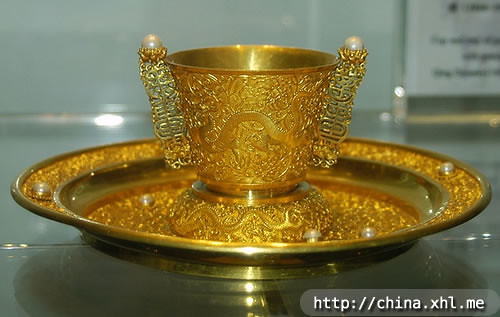
Many of the exhibits are tea sets or dinner sets made of materials like gold, silver and jade.
The dinner sets were mostly made of silver as it could indicate whether or not the food was poisonous; the silver container would turn black when it contained poisonous food.
Other exhibits are old chimes, imperial seals, milk containers, Ruyi (a lucky sceptre), small incense burners and other religious vessels and bowls. The jade jar and mountain carries the good wishes of the emperor. It comes from a Chinese couplet wishing the Emperor happiness as boundless as the water in the East Sea, and his life as long as the old pine tree on the South Mountain.
There are also many pavilions, pagodas and towers made of gold or jade. These were gifts for the emperor's concubines. Also noteworthy is the gold stupa used to collect the fallen hair of Emperor QianLong's mother. It weighs more than 100 kg and is made of gold.
The treasured ivory mat deserves special attention. It is 216 cm long and 139cm wide and made of delicate ivory strips. It is said that the mat was woven about 250 years ago. Altogether, 5 mats were produced and kept in the Museum at that time. Where are these valuable treasures now? You may wonder. Well, in 1960, when the relics of the Palace Museum were catalogued, only one was found, the other four had simply disappeared. A few years later, the Shangdong Provincial Museum in East China collected one from a local peasant. The peasant said that the ivory mat was brought there by a local pearl broker and in turn, he sent it to a nearby noble at the beginning of the century. The peasent had received the mat as part of the distribution during the Land Reform of the 1950s.
So how did this treasure fall into the hands of a pearl broker? Specialists believe that the mat was stolen by the Anglo-French force that invaded China in the 1900s, and later sold to the pearl broker. Another possibility is that it was stolen and sold by a court eunuch. Regardless of the reason, it is fortunate that this Chinese artifact was recovered. Later, when the Palace Museum was sorting out Taiwanese bamboo mats, surprisingly, another ivory mat was found hidden among them. This ivory mat was treated by a special process, and even today, it can be easily rolled up. It is a pity that the technique has been lost!
Not only can ivory be made into mats, but feathers have also been woven into beautiful garments. In 1983, two feather dresses of the Miao Nationality were discovered in a peasant's home. Made from the feathers of more than 100 birds, each coat has three distinctive parts, each part able to serve as a child's coat by itself. Though more than 300 years old, the feather coat has remained bright and colorful. It is said that it was left by a king's concubine of the Miao Nationality.
Unlike feather coats, jade clothing was made for the deceased. During the Han Dynasty about 2,000 years ago, it was fashionable to dress deceased emperors or nobles with this attire. Three styles existed : using gold, silver or copper thread to sew the jade slip together. The emperor wore the garment sewn in gold, kings and princesses wore ones sewn in silver, while other officials and nobles had ones sewn in copper thread. The jade slips somewhat resemble shining fish scales.
Each was made of more than 2,000 jade pieces. The gold threads used in the garment weigh about 1,800 grams. Most of the jade pieces are rectangular or square in shape, some are also triangular or other shaped. It is clear when examining the garment that each jade piece has been polished and every hole carefully drilled. At least ten different procedures were involved, including material selection, drilling and polishing. Specialists say that even with today's technology, it would take a jade carver ten years to complete one of these outfits.

The exhibits we have discussed are only a small portion of the treasures of the Forbidden City. And the items on display are only a part of the total collection. So it is difficult to imagine how many treasures there were originally in the Forbidden City. When the KuoMingTang government of Chiang Kai Shek fled the mainland for Taiwan, they packed almost everything movable. Altogether, 2,972 cases of treasures were shipped to Taiwan. Nonetheless, what you can see today provides a good taste of the treasures of the Forbidden City.


The Hall of Paintings(Chinese: 珍画殿)
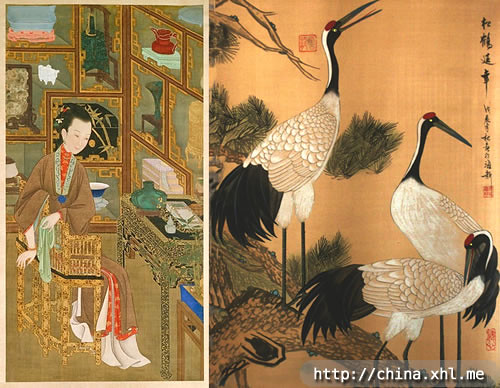

Qing Emperor QianLong.
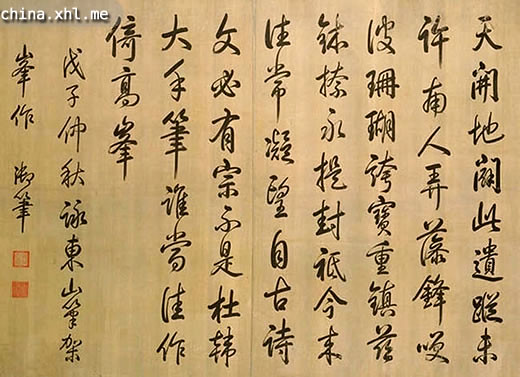
Qing Emperor QianLong's calligraphy.
The Nine Dragon Screen(Chinese: 九龙壁)

Facing the Gate of Imperial Supremacy is the famous Nine Dragon Screen, the biggest in China.
It was built in 1771 during the reign of Qing Emperor QianLong.
Until recently, there were altogether three Nine Dragon Screens in China. The oldest one is located in Datong city, Shanxi Province; it was built during the Ming Dynasty (1368-1644). The third was built in Beihai Park during the Qing Dynasty (1644-1911), which is within walking distance from the Forbidden City. The one in Beihai is unique in having dragons on both sides.
The most recent additon to the Nine Dragon Screen family is the one built inside the XiJiao (West Suburb) Park in Wuxi City, Jiangsu Province in 1985.
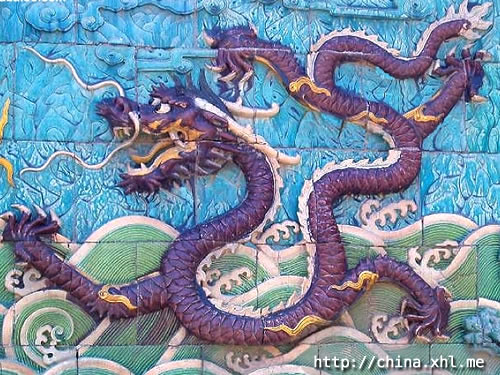
The Nine Dragon Screen is 6 metres high and 31 metres long. It is constructed with 270 glazed tiles.

Other Places of Interest
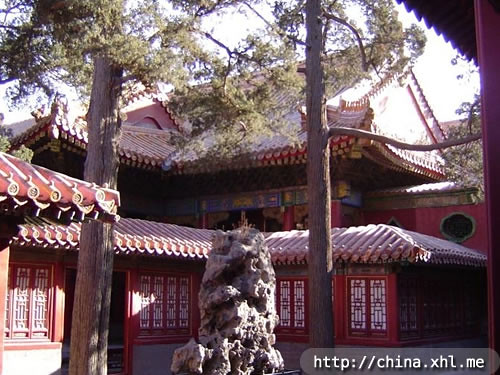
One of the many small courtyards in the Inner Court.
The Hall of Mental Cultivation(Chinese: 养心殿)
The main building to the west of the Inner Court is the Hall of Mental Cultivation. It was built during the Ming Dynasty.
Emperor KangXi of the Qing Dynasty took this hall as his study. Starting with Emperor YongZheng (1723-1735), this hall served as the living quarters for the emperors. Emperor YongZheng also took the central hall here as his office, where he could deal with state affairs. As a matter of fact, eight of the Qing Emperors both lived and worked here. Emperors ShunZhi, QianLong and TongZhi even died here.
The central hall was the office in which the emperor met foreign diplomats, and summoned his officials for consultation. It was also here that the last emperor in Chinese history, Emperor PuYi, announced his resignation.
Emperor YongZheng named the western hall the Hall of Three Rare Treasures. This referred to three outstanding calligraphy masterpieces by Wang Xizhi, Wang Xianzhi, and Wang Xun, three pioneers in Chinese calligraphy. Emperor YongZheng, a great calligraphy lover himself, had a collection of the outstanding works by the three Wang's, hence the name.
The emperor's seat is well arranged for reading and writing, and the writing brushes and inkstones are placed in proper order. Secret talks on political and military affairs also took place here. The screen partition in front was supposed to stop the secrets from leaking out.
The eastern hall is of historical significance. This was the site of the well known 'power behind the throne' or 'behind the screen'. Most people think that only Empress Dowager Ci'Xi gave audience behind the screen, but in fact, this was first jointly practiced by the Empress Dowager Ci'Xi and another empress called Ci'An. However, the sudden death of Empress Ci'An in 1881 left the power solely to the Empress Dowager Ci'Xi. Empress Ci'An was believed to have been poisoned by Ci'Xi.
Ci'Xi ruled over China for about 40 years from behind the yellow screen. She had to stay behind the screen all the time because at that time in China women weren't supposed to be in the Outer Palace or to hold any public positions! If you have a close look at the setting here, you will find that a lot of scenes were shot here for the film 'The Last Emperor', the first western film made in China.
This last emperor was PuYi just a child when chosen by Ci'Xi as her next puppet. The next day the imprisoned emperor was poisoned (probably) but that day CiXi also died. Within four years came the Republican revolution and PuYi was forced to abdicate.
The Six Western Palaces(Chinese: 西六宫)
These palaces are located north of the Hall of Mental Cultivation, three palaces on each side of an alley from north to south. They were the living quarters for the empress and the concubines. The original layout and decor has been preserved to offer visitors some ideas about the way of life that the imperial family led. The original 18th and 19th century furniture is on display. Also on display are some fine paintings illustrating the famous novel 'Dream of the Red Chamber'.
The Empress Dowager Ci'Xi lived in the Palace of Eternal Spring (Chang Chun Gong) during the reign of TongZhi. The last emperor's wife lived in the Palace of Accumulated Elegance (Chu Xiu Gong) until 1924 when she and Emperor PuYi were expelled.
In the past, there was a well known saying - that "3,000 beauties live in the Inner Court". It actually referrd to those women (concubines) living in the Six Western Palaces.
When the emperor fancied company at night, he would write the name of his desired concubine on paper and the on-duty eunuch would go to fetch her. She would be stripped naked, to make sure she was without weapons, then rolled in a rug, carried to the emperor's chamber and deposited at the foot of the bed. A few of the emperors were cruel and some of the concubines were killed.
Apart from the emperor and his sons, all other males in the Forbidden City were eunuchs, castrated at start of service, before entry. The purpose of this was to be sure that any children born belonged to the emperor.
The Six Eastern Palaces(Chinese: 东六宫)
The Six Eastern Palaces stand on the other side of the central north-south axis. Most of these palaces were restored in the 17th century. They were also the living quarters for the empresses and concubines.
Today, they have mostly been turned into special exhibitions such as the Museum of Bronzes and the Museum of Ceramics.
East of the Six Palaces lie the store-houses for tea and some of the brocades. The Five Northern Kitchens (BeiWuChu) to the north fed everyone living in the eastern part of the inner court.
The Palace for Fasting(Chinese: 斋宫)
The Emperors were expected to fast the night before they offered sacrifices to Heaven. As a general rule, the emperors stayed here for the first two days of their fast and then moved to an imperial residence within the confines of the Temple of Heaven.

During the fast, the emperors abstained from wine, onions, garlic, chives, praying, involvement in petty affairs and making love. It must have been quite a task for them!
Doorways(Chinese: 门框)
The Forbidden City has many beautifully constructed and decorated doorways.



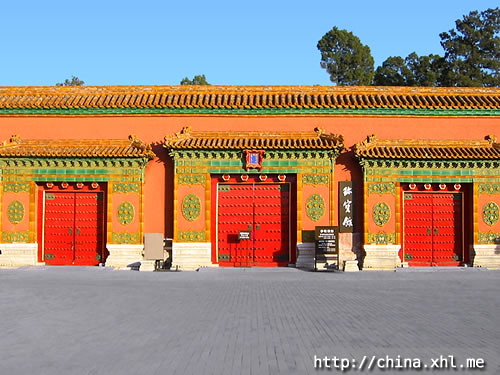
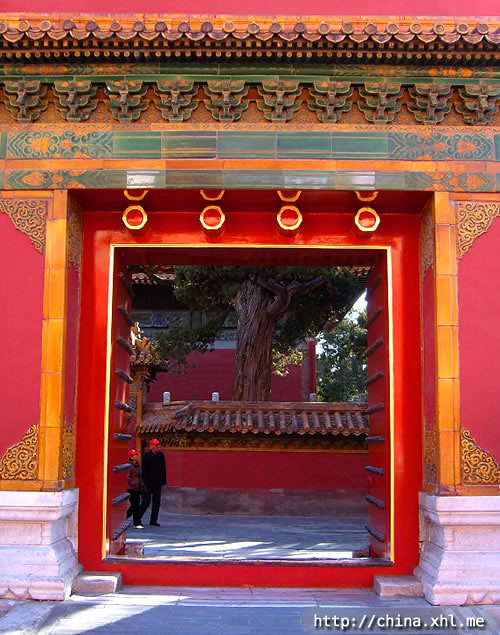



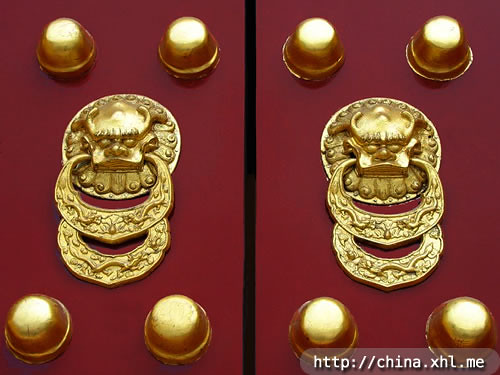
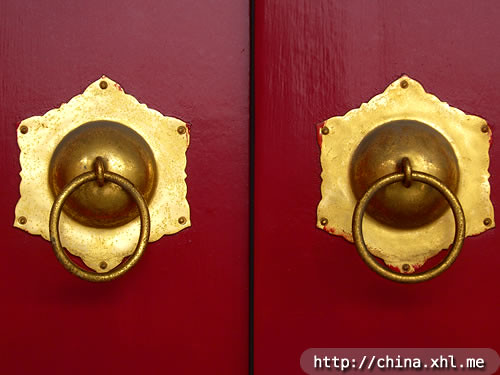
Pots(Chinese: 罐)
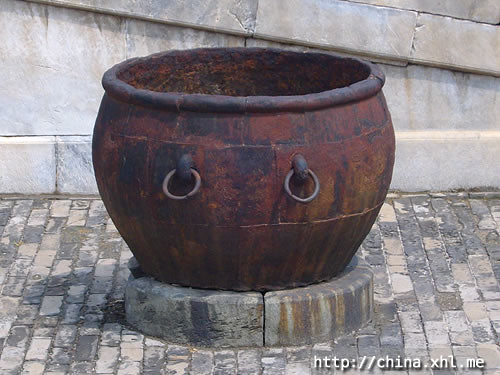
A nicely rusted iron vat.
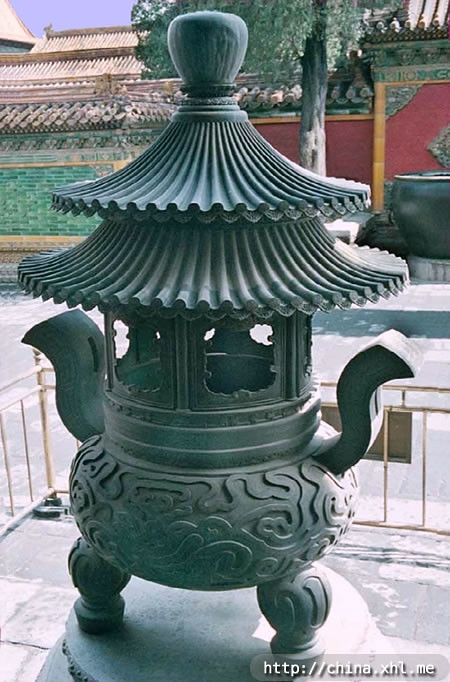
An incense burner.
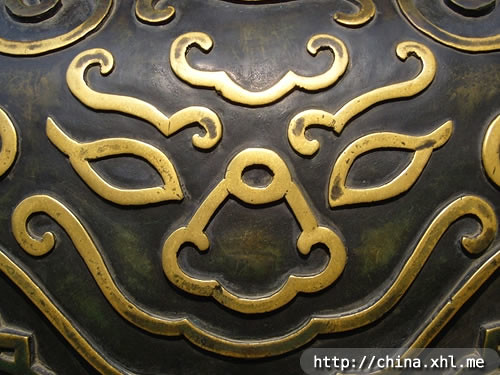
Close-up view of incense burner decoration.

Bronze vat.

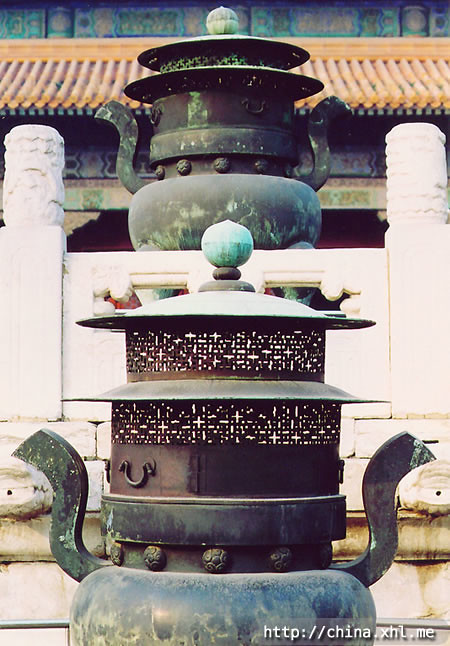
Two Dings.
Sculptures(Chinese: 雕塑)
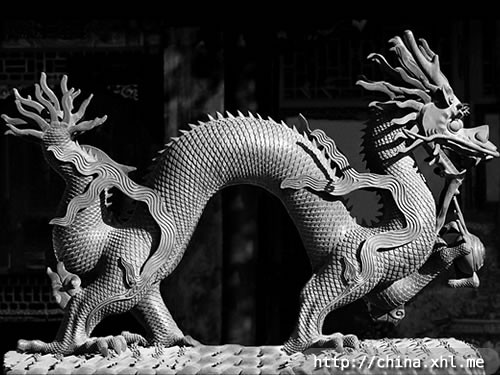
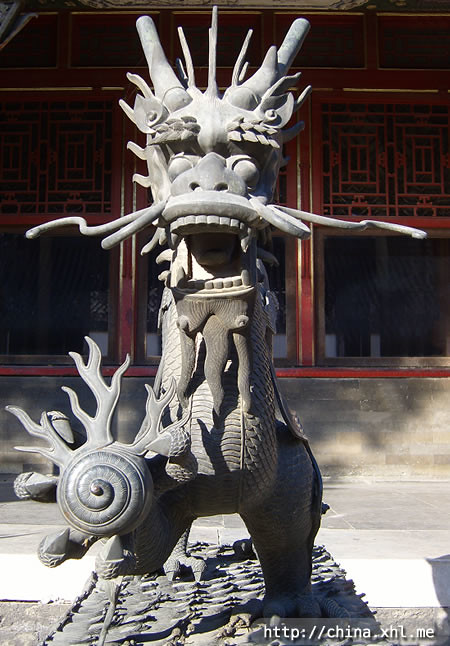


Tortoise.
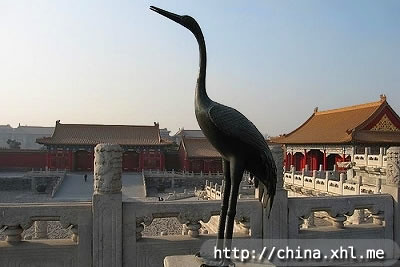
Crane.

Elephant.

Lion cub.
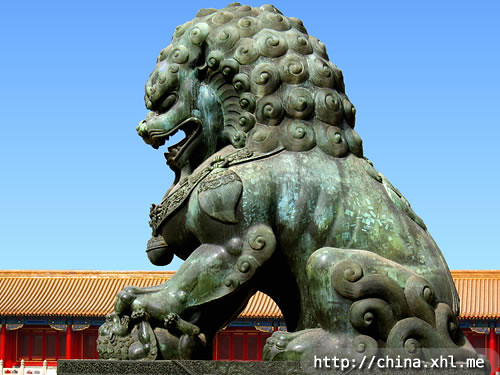

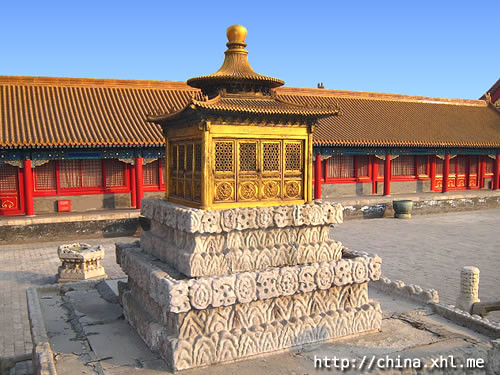
Decorative Tiles(Chinese: 装饰釉面砖)
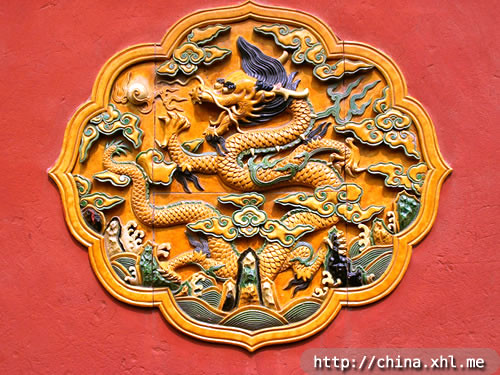

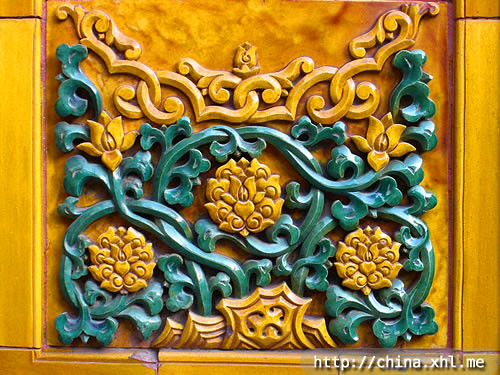




Roofs(Chinese: 屋顶)
As early as the neolithic period, a basic principle of Chinese architecture was already established, wherein columns spaced at intervals, rather than walls, provided the support for the roof. Walls came to serve merely as enclosing screens.

Although the typical Chinese roof probably developed during the Shang (c.1523-1027 B.C.) or the Chou (1027-c.256 B.C.) period, its features are unknown to us until the Han dynasty. Then it appeared in the form that we recognize today as a hallmark of Chinese architecture - a graceful, overhanging roof, sometimes in several tiers, with upturned eaves. The roof rests on a series of four-part brackets, which in turn are supported by other clusters of brackets set on columns.
Decorative possibilities were soon realized in the colorful glazed tiling of roofs and the carving and painting of brackets, which became increasingly elaborate.
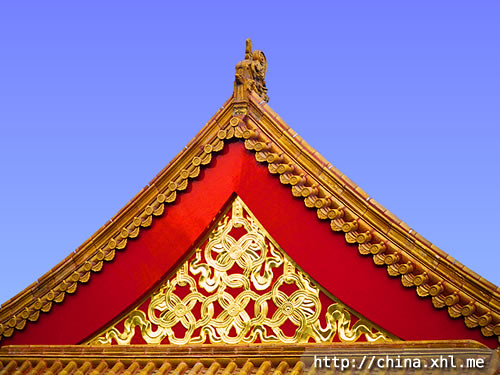
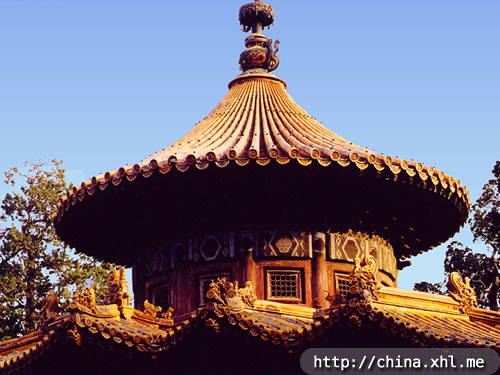

Painted Decoration(Chinese: 装饰彩绘)
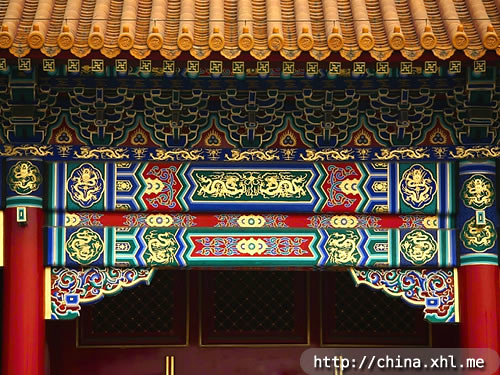
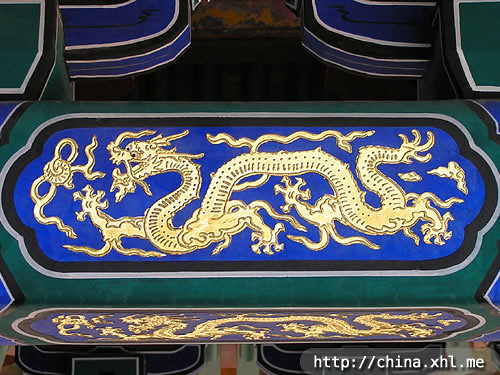
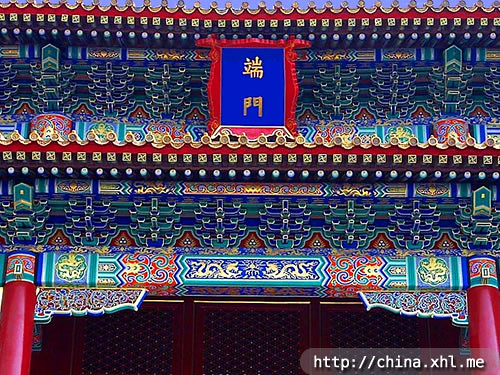
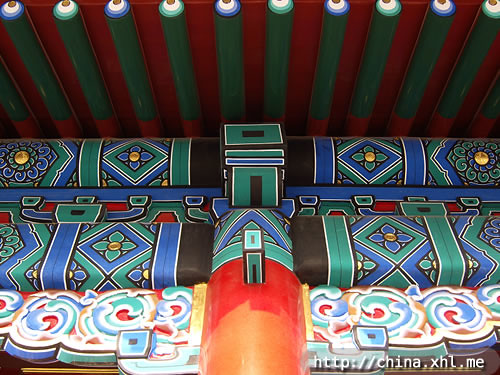

Ceilings(Chinese: 天花板)

Windows and Doors(Chinese: 门窗)
Window Shutters (窗扇)
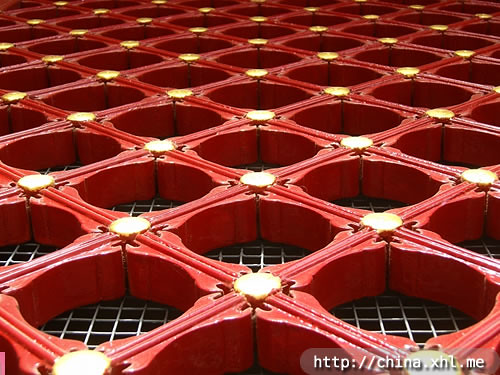

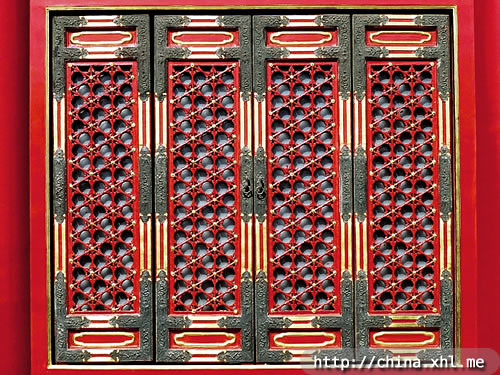

Doors (门)
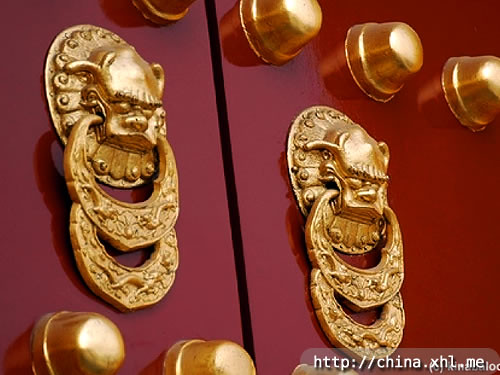
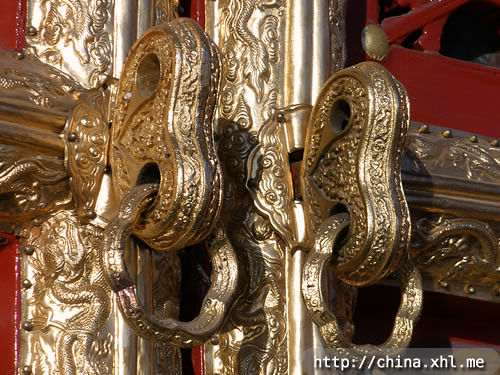
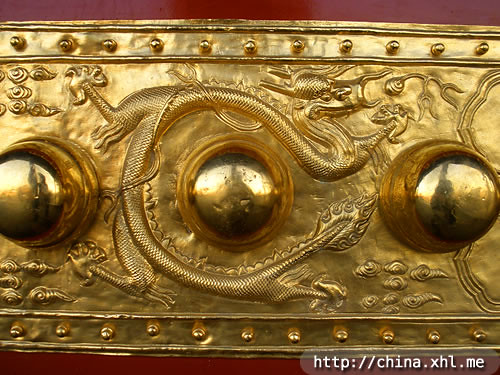
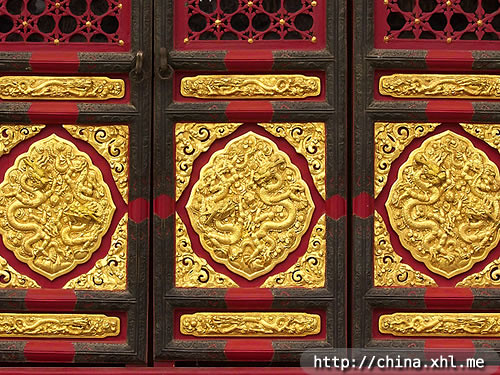
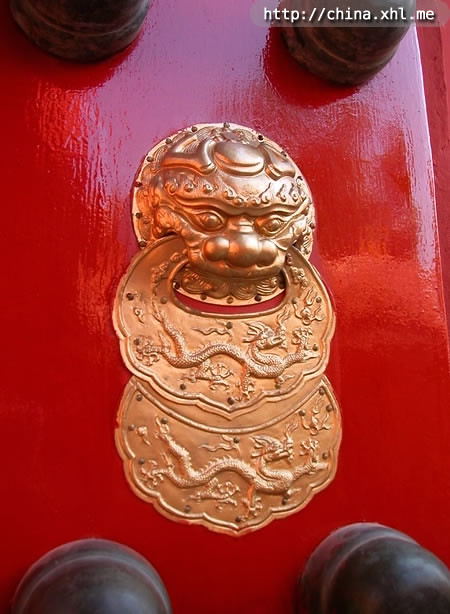

Miscellaneous Signs
Gargoyles(Chinese: 滴水龙嘴)
There are over 1000 gargoyles around the raised platform for the Outer Court halls. In heavy rain, look out for each becoming a fountain as rain drains out through each mouth (except those in the corners).
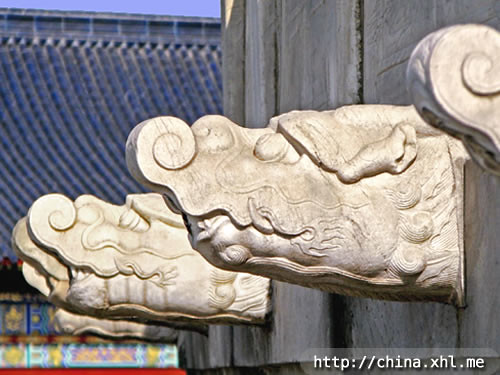


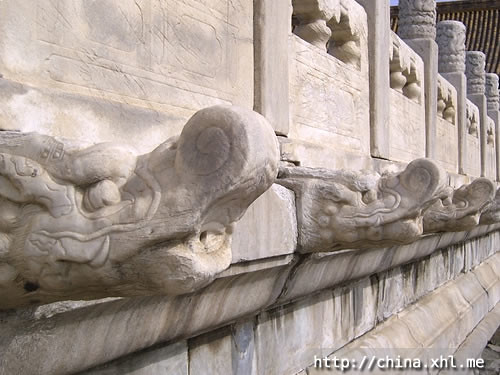


Ballustrades(Chinese: 玉石栏)

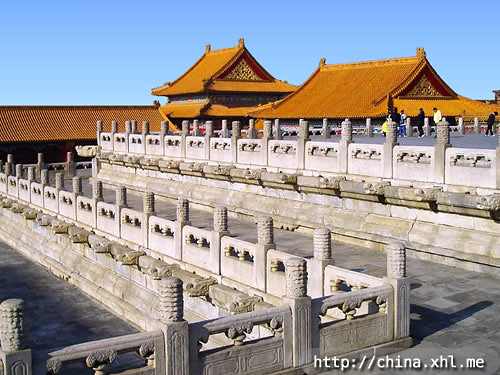

Inner Walls(Chinese: 内墙)


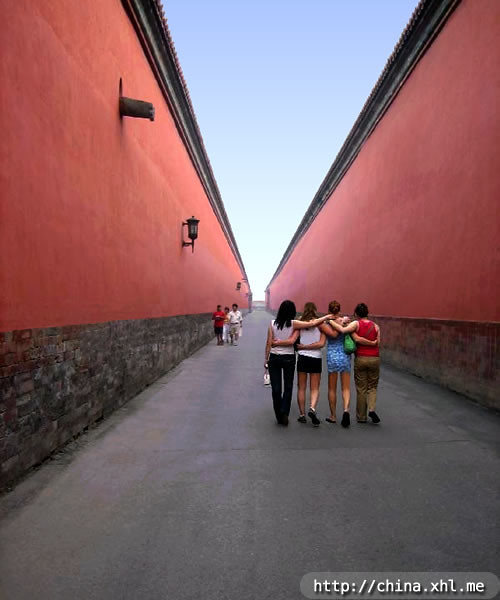
Screens(Chinese: 屏风)
Screens provided protection for doorways in that one cannot see straight inside. Screens perform protection also in terms of Feng Shui principles.

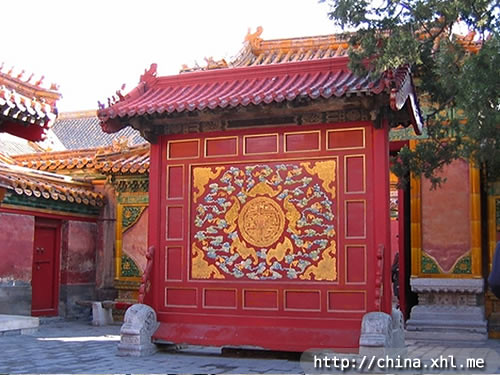
Sunset at the Forbidden City(Chinese: 紫禁城的夕阳美景)


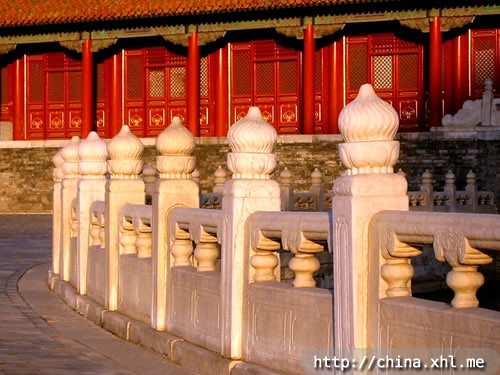

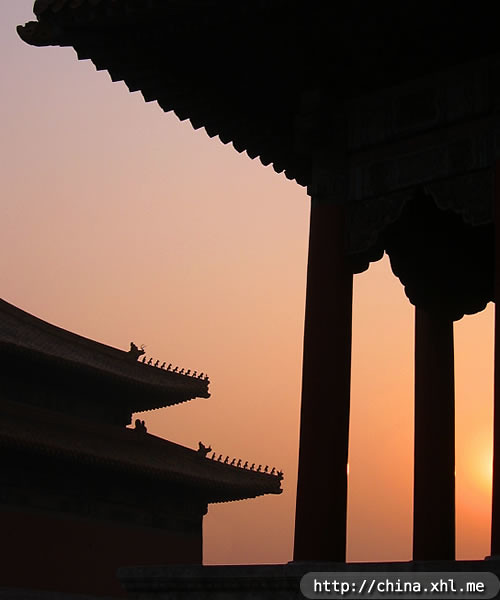
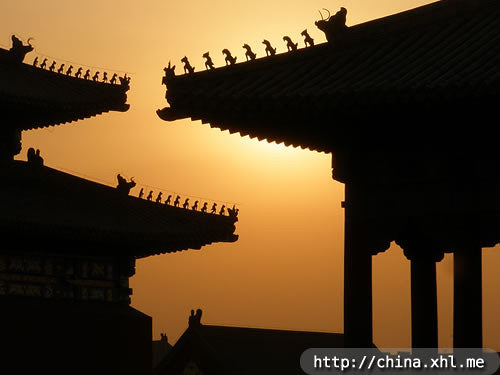
Tags: Beijing, Forbidden City, Palace Museum
One Comment
March 25th, 2013 at 04:31 pm
This blog is amazing. I realy like it! johnny
Leave a comment